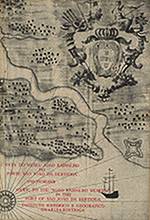|
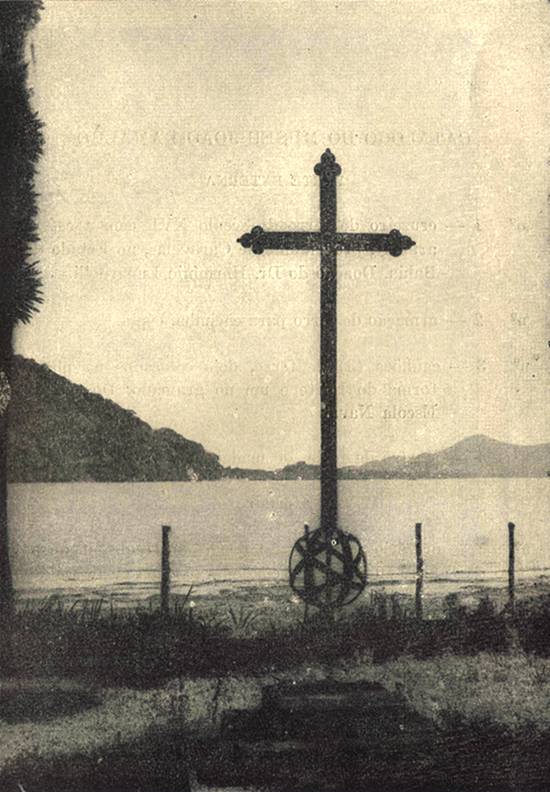
See nº 1 in the Catalogue
Foto publicada na página 19 do livrete
Catalogue of the João Ramalho Museum
"OUTSIDE PART"
Nº 1 – 16th. Century iron cross with the armillary sphere, from Caravelas, Bahia, and donated by dr. Hermínio Lunardelli.
Nº 2 – iron base for fresh-water pits (copy)
Nº 3 – 3 iron cannon. Two are in the fort's platform and the other on the lawn. Donated by the Naval Academy.
Nº 4 – wooden feast staff, coloured.
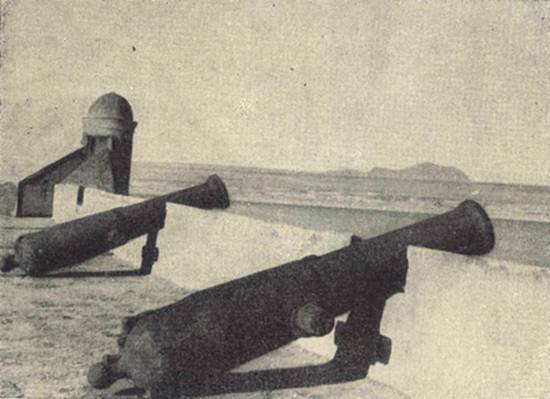
See nº 3 in the Catalogue
Foto publicada na página 51 do livrete
"Porch"
Nº 5 – 17th century jesuitical oratory, 1,10 by 0,83 by 0,21.
Nº 6 – wooden candelabra (19th century cedar, 0,60 m height).
Nº 7 – small wooden crucifix, painted in green, Christ figure made of lead. Donated by dr. Pedro de O. Ribeiro Neto.
Nº 8 – stone baptismal font, from the church of Cubatão with 0,48 m in diameter.
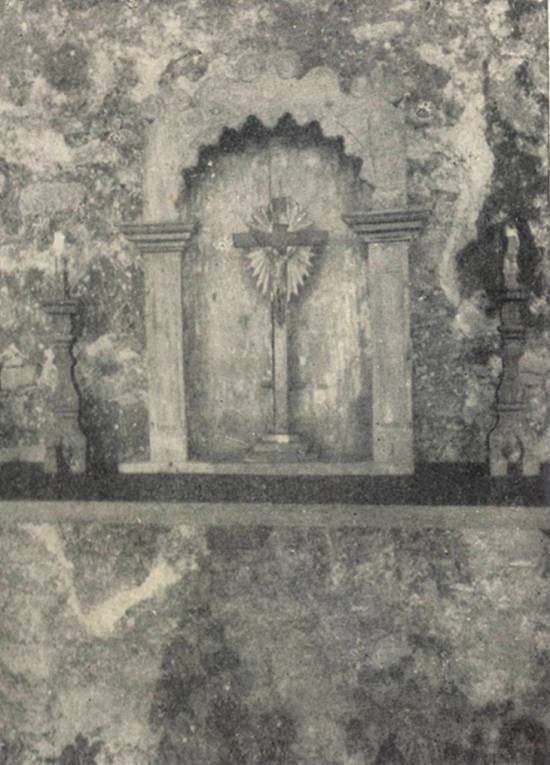
See nº 5 in the Catalogue
Foto publicada na página 52 do livrete
Nº 9 – colonial confessionary, in cinnamon wood, painted in blue, 1,65 m in height. Donated by Lúcia Figueira de Mello Falkenberg.
Nº 10 – pair of altar vases, done in wood, imitating marble, 0,33 m in height. Donated by Mr. Francisco Roberto.
Nº 11 – wooden crucifix painted in black, gold-carved. Christ done in wood, 0,74 m in height. Donated by Mr. Paulo Monteiro.
Nº 12 – poetry written by Padre Anchieta, translated from the tupy dialect by Pedro de Oliveira Ribeiro Neto and dona in parchment. Offered by J. T. C. Chaguri (calligrapher). See
text on page 29. (N. E.: correct is page 60)
Nº 13 – Jesus with the cross. Foundin a litoral chapel.
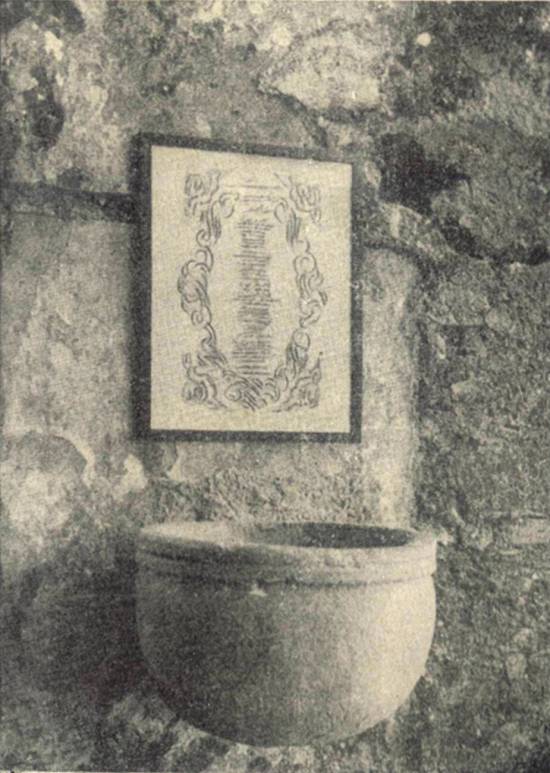
See nº 8 in the Catalogue
Foto publicada na página 52 do livrete
INTERIOR
"Entrance Room"
Nº 14 – rustic table from São Paulo coast, in cinnamon, 0,85 m in height, top 1,27 m by 0,63 m.
Nº 15 – pair of folding chairs, of the type called "Bandeirantes" because of their easy transportation on animal backs.
Nº 16 – pair of wooden rustic colonial chairs, woven rush seats, 17th. Century type, pentagon-form backs. They were in use in Brazil, in Spain and her American colonies.
Nº 17 – bean-woodbowl used on the coast.
Nº 18 – flag of the Quinas, with staff.
Nº 19 – flag of the Order of Christ, with staff.
Nº 20 – picture of João Ramalho – Done by Hermann Greiser; title by Aureliano Leite.
Nº 21 – 17th. Century polycromic map representing part of the coast and on which the Fort São João da Bertioga is marked. From the work of Carmel
priest João José de Santa Teresa, "Istorie delle guerre del Regno del Brasile accudate tra la corona di Portugallo e la Republica di Ollanda composta e offerta allo sagra Reale Maesdá di Pietro Secondo Ré di Portugallo", Roma, 1698. This map
is reproduced in our cover. Donated by Dr. Herminio Lunardelli.
Nº 22 – chest used for keeping money – used by the "Bandeirantes", in custody.
Nº 23 – Ground-plant of the Fort, copy of the original kept in São Paulo State Archives. 1817 [1]
Nº 24 – the poem "Celula Mater" by poet Pedro de Oliveira Ribeiro Neto, done in gothic letters by J. T. C. Chaguri.
Nº 25 – pair of iron lamps. Donated by Mr. Francisco Roberto.
Nº 26 – colonial thre-footed stool, in cedar-wood.
Nº 27 – iron-tool for making hosts. Jesuitical. Donated by Zelina Castelo Branco, 0,65 m branches, engraved plaques 0,15 m.
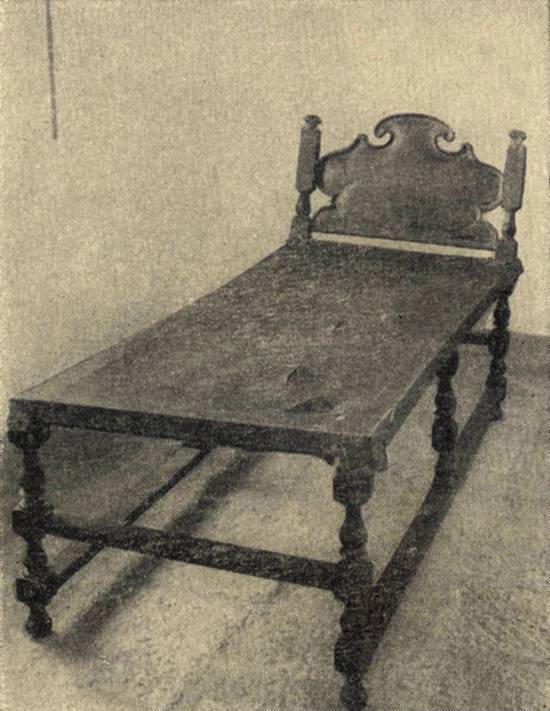
See nº 28 in the Catalogue
Foto publicada na página 55 do livrete
"Officer's Room"
Nº 28 – cot in jacarandá wood, leather mattress, carved head, turned feet, pyramid finish posters. Transition period piece, with details of the 17th. And 18th. Centuries. Bed is
1,65 m by 0,70; height 0,50 m. Donated by Dr. Hermínio Lunardelli.
Nº 29 – primitivo wooden crucifix from São Paulo, with polichromed figures of Chrsit and of Our Lady. 0,36 m in height. Donated by Mr. Francisco Roberto.
Nº 30 – low table in cinnamon wood, from the paulista coast. Topis 1,00 m by 0,62 m; 0,47 m in height.
Nº 31 – colonial oratory in painted wood, 0,78 m in height, 0,40 m in width and 0,20 m in depth. Donated by Mrs. Rita Lebre de Mello Corrêa Dias.
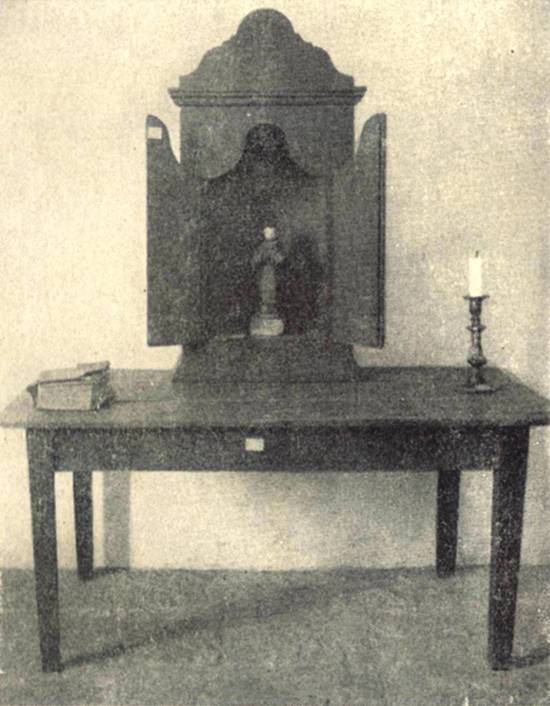
See nºs 30 and 31 in the Catalogue
Foto publicada na página 52 do livrete
Nº 32 – wooden tabouret with leather seat, from the São Paulo coast, 0,48 m in height, seat 0,32 m.
Nº 33 – earthen pot from São Paulo.
Nº 34 – Saint Dominique, clay image from São Paulo, 0,24 m in height. Donated by Mrs. Rita Lebre de Mello Corrêa Dias.
Nº 35 – old pewter candlestick, 0,20 m in height. Donated by Mr. Francisco Roberto.
Nº 36 – 1789 missal, edited by Belin in French, leather cover. Donated by Pedro de Oliveira Ribeiro Neto.
Nº 37 – clay waterpot from the litoral.
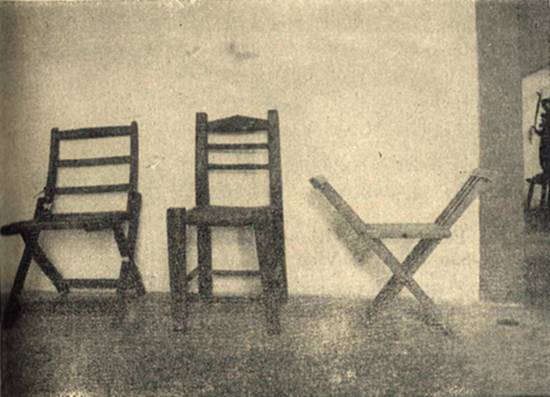
See nºs 15-16 and 38 in the Catalogue
Foto publicada na página 55 do livrete
Nº 38 – jointed cinnamon-wood chair, worked leather seat, wooden back,a 17th. Century piece. Donated by Lúcia Figueira de Mello Falkenberg.
Nº 39 – painted wooden rack, with six arms and shelf. Length, 1,70 m, 0,24 m in depth and 0, 27 m in height. Donated by Mr. Francisco Roberto.
Nº 40 – fringed cotton towel donated by Mrs. Rita Lebre de Mello Corrêa Dias used in the 7th century.
Nº 41 – ark made of cedar-wood, with iron holders and locker.
Nº 42 – old iron lamp used with whale oil in the coast. Donated by Mr. Marina José Botelho Egas.
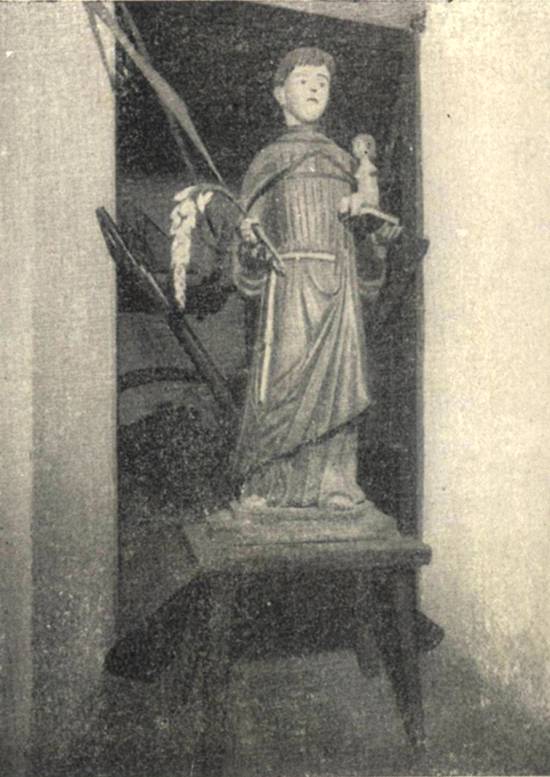
See nº 43 in the Catalogue
Foto publicada na página 52 do livrete
"Corridor"
Nº 43 – cedar-wood image of Saint Anthony, with book and the Infant Jesus, belonging to the Hermitage of St. Anthony of Guaibe, on the island of Santo Amaro (in custody).
Carved-work of the 17th. Century. 0,95 m in height.
Nº 44 – Key founded in the Hermitage of St. Anthonyof Guaibe.
Nº 45 – small tabouret used on the São Paulo coast.
Nº 46 – Feast flag staff, made of wood aind picturing St. John, St. Anthony, St. Peter and St. Benedictus. Donated by Mr. Francisco Roberto.
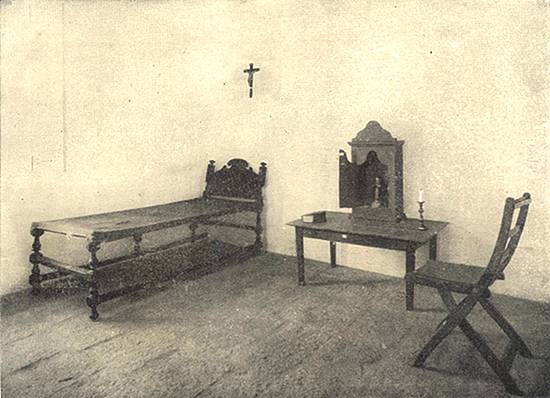
Officer's room
Foto publicada na página 50 do livrete
"Dungeon"
Nº 47 – cot in light brown jacaranda wood, a 17th century piece, with straight feet, wooden mattress, pentagonal head ending in a closed angle; very much in use on the coast of São
Paulo. Polyedric finishings in the two bed-head posters.
Nº 48 – wooden crucifix from São Paulo, Christ figure in clay. Donated by Mr. Francisco Roberto.
Nº 49 – cedar-wood tabouret, from the coasat.
Nº 50 – earthen pot from São Paulo.
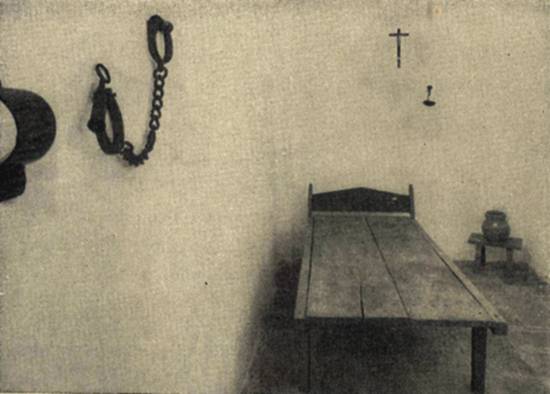
See nº 47 in the Catalogue
Foto publicada na página 54 do livrete
Nº 51 – iron-tool for torturing slaves. Colonial period. Belongs to Mr. Francisco de Barros Mello.
Nº 52 – jointed iron-shakle for the ankle. Same.
Nº 53 – slave neck-chain with iron-tool to hinder run-away slaves when fleeing through the woods. Same.
Nº 54 – ancient chain. Donated by Mrs. Maria José Botelho Egas.
Nº 55 – handeuffs for prisoners and slaves, with key.
Nº 56 – old lamp.
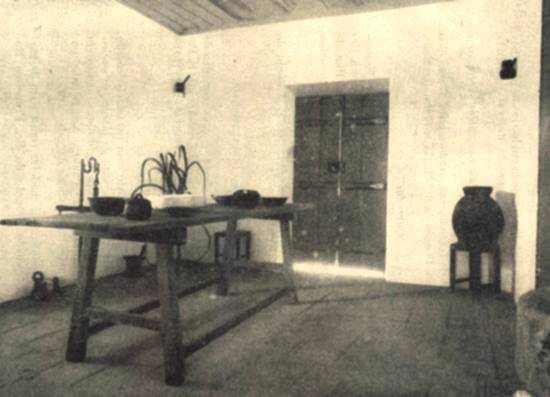
Dining-room
Foto publicada na página 27 do livrete
"Dinning-Room"
Nº 57 – large old table in cedar-wood, feet on props. Top 2,35 m, bk 0,75 m in height.
Nº 58 – 4 old tabourets with leather seats, from the coast of São Paulo.
Nº 59 – olden iron scales less plates. Support is 1,21 m in height, arms are 0,77 m.
Nº 60 – mortar come from the coast. 0,80 m in height.
Nº 61 – three mortar hands, made of different kinds of wood. From the coast.
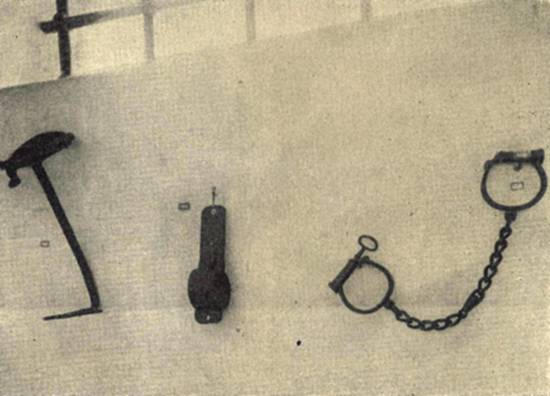
See nºs 52-53 and 54 in the Catalogue
Foto publicada na página 54 do livrete
Nº 62 – old wooden stool.
Nº 63 – small copper-pot, restored.
Nº 64 – clay-pot with holders.
Nº 65 – soup-plate made of clay.
Nº 66 – round wooden-bowl with cars, made of coastal wood.
Nº 67 – iron lamp.
Nº 68 – iron mortar with hand, 0,13 m in diameter, 0,20 m in height, hand 0,30 m. Belongs to Mr. Francisco de Barros Mello.

See nº 57 in the Catalogue
Foto publicada na página 55 do livrete
Nº 69 – small bronze mortar, with hand. Same.
Nº 70 – three old scale weights, with handles. Same.
Nº 71 – old iron tankard. Donated by Mr. Francisco Roberto.
Nº 72 – large old clay water tankard (modern tap). Donated by dr. E. F. Brancante.
Nº 73 – Earthen pot from Parati Rio State. Donated by Mr. Francisco Roberto.
Nº 74 – clay-bowl from Embú. Donated by Mr. Francisco Roberto.
Nº 75 – small earthen pot with lid. Same.
Nº 76 – small earthen utensil. Same.
Nº 77 – old iron lamp.
Nº 78 – two old chairs with woven rush sets 17th century. In custody.
"Corridor to the Weapon-Room"
Nº 79 – old iron lamp. Donated by Mrs. Marina Brito.
Nº 80 – nailed leather ark with the initials J. J. S., measuring 0,67 m by 0,34 m. 0,41 m in height. Donated by Lúcia Figueira de Mello Falkenberg.
Nº 81 – wooden ark support.
Nº 82 – Panel representing the Tower of Belém, by Gontran.
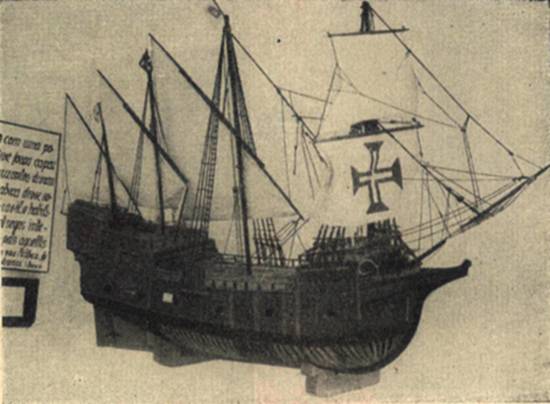
See nº 88 in the Catalogue
Foto publicada na página 51 do livrete
"Weapon Room"
Nº 83 – 84 – 85- 86 – Four panels representing Portuguese navigation and colonization, by Gontran.
Nº 87 – large iron mortar without hands. 0,26 m in height, mouth 0,27 m. Donated by Mrs. Maria José Botelho Egas.
Nº 88 – model caravel belonging to the Military Museum of São Paulo (in custody).
Nº 89 – model boat used on the litoral, from "Montão do Trigo" island.
Nº 90 – whale bone and vertebrae, found near the Fort.
Nº 91 – seven iron cannon balls found inside the Fort by Mrs. Lúcia Figueira de Mello Falkenberg.
Nº 92 – iron chain with hooks. Donated by Mrs. Maria José Botelho Egas.
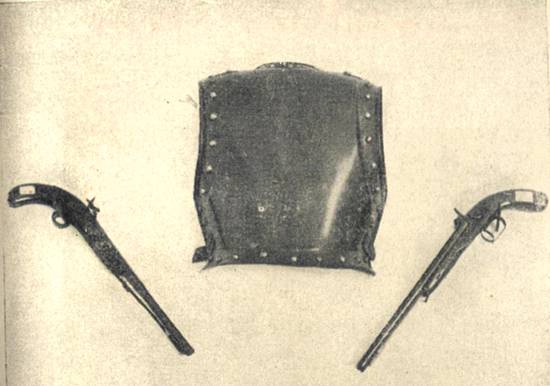
See nºs 93 and 105 in the Catalogue
Foto publicada na página 53 do livrete
Nº 93 – old armour (back and brast). Donated by Dr. E. F. Brancante.
Nº 94 – rapier of Portuguese origin, pertaining to the "Bandeiras" period, with the following inscription: "Puna pella Patria". Loan (already returned).
Nº 95 – Spear used in Brazil. 18th century.
Nº 96 – old iron lantern.
Nº 97 – sword with metal handle, leather sheath, plate in German steel, marked "Alex Copel – Solingen". Probably used by the São Paulo Militia. Donated by Mr. Aurélio Soares Nerino.
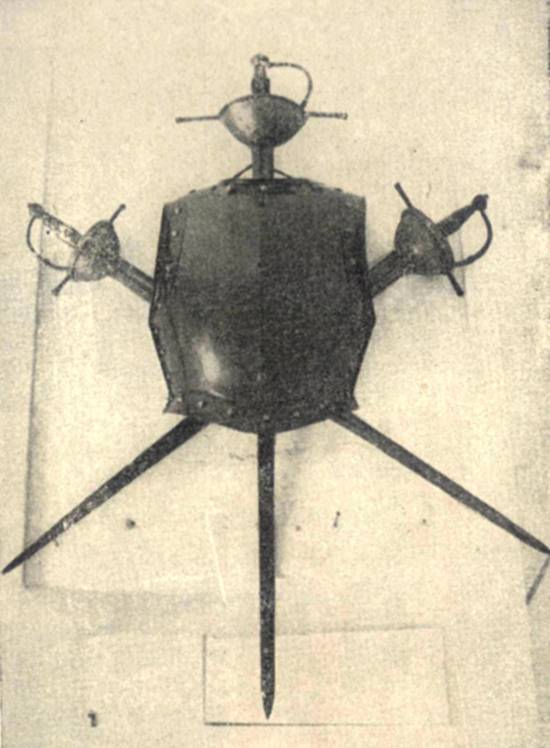
See nºs 93 and 94 in the Catalogue
Foto publicada na página 53 do livrete
Nº 98 – 19th century gun. Donated by Mrs. Maria Carlota Pinto Coutinho.
Nº 99 – small gun used the 19th century; same.
Nº 100 – three indian Stone Axes. Donated by Mrs. Lúcia Figueira de Mello Falkenberg.
Nº 101 – indian stone axes in wooden casae, belonging to Mr. Francisco de Barros Mello (in custody).
Nº 102 – two-barreled pistol from the 19th century. Donated by Mrs. Maria Carlota Pinto Coutinho.
Nº 103 – iron crotch for hand-gun. Donated by Mr. Francisco Roberto.
Nº 104 – ancient pike from the colonial period. Donated by Mr. Francisco de Barros Mello.
Nº 105 – two ancient guns (with one and two barrels), belonging to Mr. Francisco de Barros Mello (in custody).
Nº 106 – treaked iron cannon ball. Same.
Nº 107 – ancient "ripper" baionet. Same.
Nº 108 – navy baionet. Same.
Nº 109 – ancient hand-guns, of various makings and periods. Belonging to Mr. Francisco de Barros Mello (in custody).
Nº 110 – cordage and net.
Nº 111 – ancient dagger of Spanish origin. Donated by Mr. Pedro de Oliveira Ribeiro Neto.
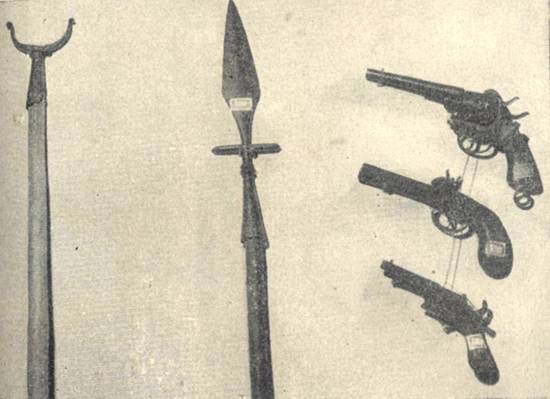
See nºs 94-95-98-99-103 and 104 in the Catalogue
Foto publicada na página 53 do livrete
"Hans Staden Room"
Nº 112 – pictorial history of Hans Staden's life in Brazil and his imprisonment, by the Tupinambá Indians, for 9 months.
Nº 113 – Small salvo cannon. Donated by Mr. Erico Stickel.
Nº 114 – showcase containing: Hans Staden's book (1593), sun dial of the 17th century (in custody) – belongs to Mrs. Lúcia Figueira de Mello Falkenberg); 3 ancient coins found
inside the fortress.
Nº 115 – idem, containing indian ceramic. Donated by Mr. Dr. Durval Bruza.
Nº 116 – 2 cinnamon wood stols, characteristic of the 17th century. In custody.
Nº 117 – two earthen pots from the litoral.
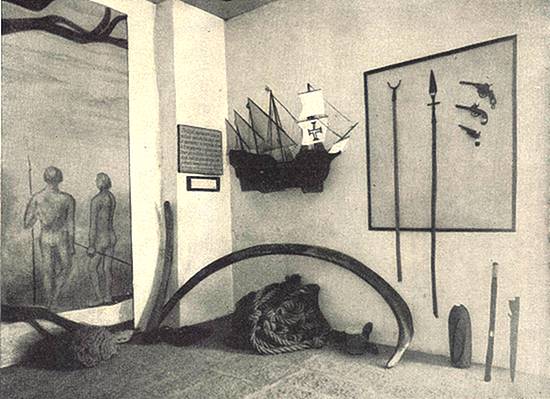
One of the Museum rooms
Foto publicada na página 25 do livrete
Flour Room
Nº 118 – flour maker from the coast of São Paulo, containing: spindle, press, bowl, "tipiti" (and-made basket), grater, oven and copper-plate for the oven.
Recent donations
Nº 119 – pistol from 19th century ("weapon room").
Nº 120 – Round woodbowl – Freom the litoral ("dining room").
Both donated by Mr. Manoel Gomes Romero Filho – Bertioga.
[1] This plant of the
fortress was used for the restoration.
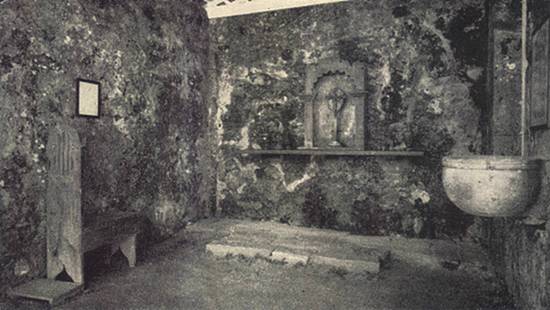
Oratory in the porch
Foto publicada na página 21 do livrete
|

